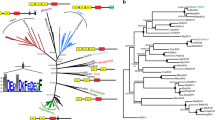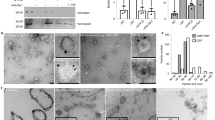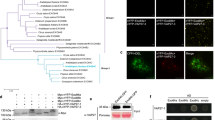Abstract
In plants, vacuolar H+-ATPase (V-ATPase) activity acidifies both the trans-Golgi network/early endosome (TGN/EE) and the vacuole. This dual V-ATPase function has impeded our understanding of how the pH homeostasis within the plant TGN/EE controls exo- and endocytosis. Here, we show that the weak V-ATPase mutant deetiolated3 (det3) displayed a pH increase in the TGN/EE, but not in the vacuole, strongly impairing secretion and recycling of the brassinosteroid receptor and the cellulose synthase complexes to the plasma membrane, in contrast to mutants lacking tonoplast-localized V-ATPase activity only. The brassinosteroid insensitivity and the cellulose deficiency defects in det3 were tightly correlated with reduced Golgi and TGN/EE motility. Thus, our results provide strong evidence that acidification of the TGN/EE, but not of the vacuole, is indispensable for functional secretion and recycling in plants.
This is a preview of subscription content, access via your institution
Access options
Subscribe to this journal
Receive 12 digital issues and online access to articles
$119.00 per year
only $9.92 per issue
Buy this article
- Purchase on Springer Link
- Instant access to full article PDF
Prices may be subject to local taxes which are calculated during checkout






Similar content being viewed by others
References
Dettmer, J., Hong-Hermesdorf, A., Stierhof, Y.-D. & Schumacher, K. Vacuolar H+-ATPase activity is required for endocytic and secretory trafficking in Arabidopsis. Plant Cell 18, 715–730 (2006).
Viotti, C. et al. Endocytic and secretory traffic in Arabidopsis merge in the trans-Golgi network/early endosome, an independent and highly dynamic organelle. Plant Cell 22, 1344–1357 (2010).
Nishi, T. & Forgac, M. The vacuolar (H+)-ATPases – nature's most versatile proton pumps. Nature Rev. Mol. Cell Biol. 3, 94–103 (2002).
Kane, P. M. The where, when, and how of organelle acidification by the yeast vacuolar H+-ATPase. Microbiol. Mol. Biol. Rev. 70, 177–191 (2006).
Huang, C. & Chang, A. pH-dependent cargo sorting from the Golgi. J. Biol. Chem. 286, 10058–10065 (2011).
Dettmer, J. et al. Essential role of the V-ATPase in male gametophyte development. Plant J. 41, 117–124 (2005).
Krebs, M. et al. Arabidopsis V-ATPase activity at the tonoplast is required for efficient nutrient storage but not for sodium accumulation. Proc. Natl Acad. Sci. USA 107, 3251–3256 (2010).
Brüx, A. et al. Reduced V-ATPase activity in the trans-Golgi network causes oxylipin-dependent hypocotyl growth inhibition in Arabidopsis. Plant Cell 20, 1088–1100 (2008).
Schumacher, K. et al. The Arabidopsis det3 mutant reveals a central role for the vacuolar H+-ATPase in plant growth and development. Genes Dev. 13, 3259–3270 (1999).
Cabrera y Poch, H. L., Peto, C. A. & Chory, J. A mutation in the Arabidopsis DET3 gene uncouples photoregulated leaf development from gene expression and chloroplast biogenesis. Plant J. 4, 671–682 (1993).
Caño-Delgado, A., Penfield, S., Smith, C., Catley, M. & Bevan, M. Reduced cellulose synthesis invokes lignification and defense responses in Arabidopsis thaliana. Plant J. 34, 351–362 (2003).
Geldner, N., Hyman, D. L., Wang, X., Schumacher, K. & Chory, J. Endosomal signaling of plant steroid receptor kinase BRI1. Genes Dev. 21, 1598–1602 (2007).
Irani, N. G. et al. Fluorescent castasterone reveals BRI1 signaling from the plasma membrane. Nature Chem. Biol. 8, 583–589 (2012).
Paredez, A. R., Somerville, C. R. & Ehrhardt, D. W. Visualization of cellulose synthase demonstrates functional association with microtubules. Science 312, 1491–1495 (2006).
McFarlane, H. E., Döring, A. & Persson, S. The cell biology of cellulose synthesis. Annu. Rev. Plant Biol. 65, 69–94 (2014).
Gutierrez, R., Lindeboom, J. J., Paredez, A. R., Emons, A. M. C. & Ehrhardt, D. W. Arabidopsis cortical microtubules position cellulose synthase delivery to the plasma membrane and interact with cellulose synthase trafficking compartments. Nature Cell Biol. 11, 797–806 (2009).
Crowell, E. F. et al. Pausing of Golgi bodies on microtubules regulates secretion of cellulose synthase complexes in Arabidopsis. Plant Cell 21, 1141–1154 (2009).
Gjetting, S. K., Ytting, C. K., Schulz, A. & Fuglsang, A. T. Live imaging of intra- and extracellular pH in plants using pHusion, a novel genetically encoded biosensor. J. Exp. Bot. 63, 3207–3218 (2012).
Sanderfoot, A. A., Kovaleva, V., Bassham, D. C. & Raikhel, N. V. Interactions between syntaxins identify at least five SNARE complexes within the Golgi/prevacuolar system of the Arabidopsis cell. Mol. Biol. Cell 12, 3733–3743 (2001).
Yang, X., Xu, P., Xiao, Y., Xiong, X. & Xu, T. Domain requirement for the membrane trafficking and targeting of syntaxin 1A. J. Biol. Chem. 281, 15457–15463 (2006).
Wee, E. G.-T., Sherrier, D. J., Prime, T. A. & Dupree, P. Targeting of active sialyltransferase to the plant Golgi apparatus. Plant Cell 10, 1759–1768 (1998).
Geldner, N., Friml, J., Stierhof, Y.-D., Jürgens, G. & Palme, K. Auxin transport inhibitors block PIN1 cycling and vesicle trafficking. Nature 413, 425–428 (2001).
Yin, Y. et al. BES1 accumulates in the nucleus in response to brassinosteroids to regulate gene expression and promote stem elongation. Cell 109, 181–191 (2002).
Russinova, E. et al. Heterodimerization and endocytosis of Arabidopsis brassinosteroid receptors BRI1 and AtSERK3 (BAK1). Plant Cell 16, 3216–3229 (2004).
Friedrichsen, D. M., Joazeiro, C. A. P., Li, J., Hunter, T. & Chory, J. Brassinosteroid-insensitive-1 is a ubiquitously expressed leucine-rich repeat receptor serine/threonine kinase. Plant Physiol. 123, 1247–1255 (2000).
Jelínková, A. et al. Probing plant membranes with FM dyes: tracking, dragging or blocking? Plant J. 61, 883–892 (2010).
Asami, T. et al. Characterization of brassinazole, a triazole-type brassinosteroid biosynthesis inhibitor. Plant Physiol. 123, 93–99 (2000).
Desprez, T. et al. Organization of cellulose synthase complexes involved in primary cell wall synthesis in Arabidopsis thaliana. Proc. Natl Acad. Sci. USA 104, 15572–15577 (2007).
Anderson, C. T., Carroll, A., Akhmetova, L. & Somerville, C. Real-time imaging of cellulose reorientation during cell wall expansion in Arabidopsis roots. Plant Physiol. 152, 787–796 (2010).
Zhang, G. F., Driouich, A. & Staehelin, L. A. Effect of monensin on plant Golgi: re-examination of the monensin-induced changes in cisternal architecture and functional activities of the Golgi apparatus of sycamore suspension-cultured cells. J. Cell Sci. 104, 819–831 (1993).
Ma, B. et al. Arabidopsis vacuolar H+-ATPase (V-ATPase) B subunits are involved in actin cytoskeleton remodeling via binding to, bundling, and stabilizing F-actin. J. Biol. Chem. 287, 19008–19017 (2012).
Sparkes, I. A. Motoring around the plant cell: insights from plant myosins. Biochem. Soc. Trans. 38, 833–838 (2010).
Maranda, B. et al. Intra-endosomal pH-sensitive recruitment of the Arf-nucleotide exchange factor ARNO and Arf6 from cytoplasm to proximal tubule endosomes. J. Biol. Chem. 276, 18540–18550 (2001).
Marshansky, V. & Futai, M. The V-type H+-ATPase in vesicular trafficking: targeting, regulation and function. Curr. Opin. Cell Biol. 20, 415–426 (2008).
Gidon, A. et al. Endosomal GPCR signaling turned off by negative feedback actions of PKA and v-ATPase. Nature Chem. Biol. 10, 707–709 (2014).
Sun, Y. et al. Structure reveals that BAK1 as a co-receptor recognizes the BRI1-bound brassinolide. Cell Res. 23, 1326–1329 (2013).
Martinière, A. et al. In vivo intracellular pH measurements in tobacco and Arabidopsis reveal an unexpected pH gradient in the endomembrane system. Plant Cell 25, 4028–4043 (2013).
Shen, J. et al. Organelle pH in the Arabidopsis endomembrane system. Mol. Plant 6, 1419–1437 (2013).
Schumacher, K. pH in the plant endomembrane system – an import and export business. Curr. Opin. Plant Biol. 22, 71–76 (2014).
Boutté, Y. et al. ECHIDNA-mediated post-Golgi trafficking of auxin carriers for differential cell elongation. Proc. Natl Acad. Sci. USA 110, 16259–16264 (2013).
Gendre, D. et al. Trans-Golgi network localized ECHIDNA/Ypt interacting protein complex is required for the secretion of cell wall polysaccharides in Arabidopsis. Plant Cell 25, 2633–2646 (2013).
Kang, J. S. et al. Salt tolerance of Arabidopsis thaliana requires maturation of N-glycosylated proteins in the Golgi apparatus. Proc. Natl Acad. Sci. USA 105, 5933–5938 (2008); correction 105, 7893 (2008).
Hurtado-Lorenzo, A. et al. V-ATPase interacts with ARNO and Arf6 in early endosomes and regulates the protein degradative pathway. Nature Cell Biol. 8, 124–136 (2006).
Sampathkumar, A. et al. Patterning and lifetime of plasma membrane-localized cellulose synthase is dependent on actin organization in Arabidopsis interphase cells. Plant Physiol. 162, 675–688 (2013).
Schlücking, K. et al. A new β-estradiol-inducible vector set that facilitates easy construction and efficient expression of transgenes reveals CBL3-dependent cytoplasm to tonoplast translocation of CIPK5. Mol. Plant 6, 1814–1829 (2013).
Hajdukiewicz, P., Svab, Z. & Maliga, P. The small, versatile pPZP family of Agrobacterium binary vectors for plant transformation. Plant Mol. Biol. 25, 989–994 (1994).
Schaaf, G. et al. AtIREG2 encodes a tonoplast transport protein involved in iron-dependent nickel detoxification in Arabidopsis thaliana roots. J. Biol. Chem. 281, 25532–25540 (2006).
Ho, M. N., Hill, K. J., Lindorfer, M. A. & Stevens, T. H. Isolation of vacuolar membrane H+-ATPase-deficient yeast mutants; the VMA5 and VMA4 genes are essential for assembly and activity of the vacuolar H+-ATPase. J. Biol. Chem. 268, 221–227 (1993).
Acknowledgements
We thank Yanhai Yin (Iowa State University, Ames, USA) for providing the anti-BES1 antibody, Niko Geldner (Université de Lausanne, Switzerland) for sharing pBRI1:BRI1-GFP and pHS:BRI1-YFP lines, Daniël Van Damme (VIB-Ghent University, Belgium) for advice in microscopy, and Martine De Cock (Ghent University, Belgium) for help in preparing the manuscript. This work was supported by the Marie Curie Initial Training Network ‘BRAVISSIMO’ (grant no. PITN-GA-2008-215118) to E.R., the Odysseus program of the Research Foundation-Flanders to J.F., the Max-Planck Gesellschaft to A.D., Y.Z., L.N. and S.P., the European Union Seventh Framework Programme (FP7 2007–2013) under Grant Agreement 263916 (WallTrac, Marie Curie Initial Training Network) to P.K. and the Deutsche Forschungsgemeinschaft (SFB1101 and TPA02) to K.S. Y.L. is indebted to the Belgian Science Policy Office (BELSPO) for a postdoctoral fellowship.
Author information
Authors and Affiliations
Contributions
Y.L., S.S., A.D., N.G.I., L.N., J.F, K.S., S.P. and E.R. conceived the study and designed the experiments. Y.L. performed all BR-related work, A.D., Y.Z. and P.K. performed all CesA-related work, S.S. constructed the pH sensor and did all pH measurements, N.G.I. did the AFCS uptake, Y.L., A.D., Y.Z., N.G.I., S.D.R. and I.V.H. generated materials, Y.-D. S. and K.S. did the TEM, Y.L., A.D., Y.Z., N.G.I., L.N., P.K., E.M., and V.B. did imaging, J.W. performed the chemical synthesis of AFCS, Y.L., A.D., N.G.I., S.D.R., K.S., S.P. and E.R. wrote the manuscript. All authors commented on the results and the manuscript.
Corresponding authors
Ethics declarations
Competing interests
The authors declare no competing financial interests.
Supplementary information
Rights and permissions
About this article
Cite this article
Luo, Y., Scholl, S., Doering, A. et al. V-ATPase activity in the TGN/EE is required for exocytosis and recycling in Arabidopsis. Nature Plants 1, 15094 (2015). https://doi.org/10.1038/nplants.2015.94
Received:
Accepted:
Published:
DOI: https://doi.org/10.1038/nplants.2015.94
This article is cited by
-
Actomyosin and CSI1/POM2 cooperate to deliver cellulose synthase from Golgi to cortical microtubules in Arabidopsis
Nature Communications (2023)
-
Adaptor protein complex interaction map in Arabidopsis identifies P34 as a common stability regulator
Nature Plants (2023)
-
Fluid-phase and membrane markers reveal spatio-temporal dynamics of membrane traffic and repair in the green alga Chara australis
Protoplasma (2021)
-
Protein trafficking in plant cells: Tools and markers
Science China Life Sciences (2020)
-
OsNHX5-mediated pH homeostasis is required for post-Golgi trafficking of seed storage proteins in rice endosperm cells
BMC Plant Biology (2019)



